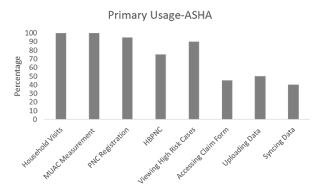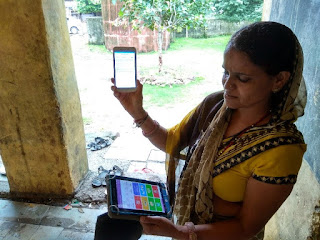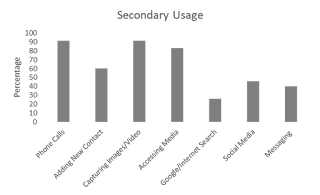


Late monsoon drizzles and an overcast sky prevails, the loo has left for better days. Walking through narrow roads of un-finished houses, the Accredited Social Health Activist (ASHA), the Anganwadi Worker (AWW) and the Auxiliary Nurse Midwife)(ANM) each make their way to work with an android tablet in their grasp – a strange sight for most locals in Khanpur block of Jhalawar district.

Anganwadi Centre – Bhatwasi village
The Antara Foundation, in partnership with the Government of Rajasthan and Tata Trusts, introduced the AAA (ANM, AWW ASHA) program which has been scaled across the state. The AAA program revolves around the idea of the frontline health workers corroborating each other’s data and working together for better service delivery. An AWW in Rajasthan is expected to maintain eleven registers to document the services she provides. These registers include her village survey, immunization, information on pregnant women and more. An ASHA, is responsible for documenting potential medical conditions in the community and determining the nutritional status of children in the community. The third frontline worker is known as the Auxiliary Nurse Midwife or ANM. The ANM is the trained medical professional in this equation and she is required to document her data in bulky Service Delivery Registers. They together form the first point of contact for delivering health based service for rural communities.
To further improve the efficiency of the AAA program, the Antara Foundation created the Rajsangam application. The primary objective of the application is to ensure the seamless exchange of information across all three frontline workers. Rajsangam has been rolled out in the Khanpur block of Jhalawar district, with 347 frontline workers being thoroughly trained in the use of the application through an Android tablet.

Ability of Anganwadi workers to utilise critical functions of the app

Ability of ASHA workers to utilise critical functions of the app
Women in rural India however, often have to live in a world of digital patriarchy, additional to the physical reality. Technology mostly only reaches men, who lord it over women. Lower levels of literacy additionally exclude women from the uprising of a digital India. For instance, ATMs have caused much distress to women in villages. It has completely removed husbands’ need for their consent to withdraw money from their accounts (Only 55% of women in rural Rajasthan own bank accounts that they themselves use – National Family Health Survey NFHS-4). The current Government of India is a strong promoter of a digital India. The digital India Campaign aims at providing government services to its citizens digitally. It encompasses; developing Infrastructure, delivering services and providing digital literacy. The use of enabling technology, in particular information and communications technology, to promote the empowerment of women has also been stated as a target of the Sustainable Development Goal 5 (SDG 5 -Gender Equality).

ASHA and AWW with their respective registers and tablets
While the Rajsangam application has evolved over the last year, time will answer whether it is an effective and sustainable intervention that can improve maternal and child health, and nutritional outcomes. What is undeniable, however, is that Rajsangam has opened the doors for women in rural areas to access modern technology.
Seema Nagar and Seema Sharma, the ASHA and AWW in Chandpura Chaplara, typically work seventeen hour days. They rise by dawn to cook for their children and milk the buffaloes. Milking the buffaloes before dawn, they say, is crucial because it can be done without the constant disturbances perpetrated by fleas. A little later and you would have a tail whack your face or dung on your feet. Having performed these duties early in the morning, Sharma then departs for the Anganwadi Centre. She is expected to update eleven registers that includes information on high-risk pregnancies and malnourished children in her community. She often has to take work home. Seema is a strong promoter of the Rajsangam application. Showing her many registers, she believes her support is obvious. Her work is streamlined and intuitive. Redundancy in record keeping is nonexistent when data is synchronized.
Modern technology belonging to Seema Nagar now makes her feel much empowered. Professionally, she finds her work to be simpler with less drudgery now. She just needs this little object to take along with her while conducting a Home-Based Post-Natal Care (HBPNC). She can click photographs and send them to her supervisors using WhatsApp. She is even part of an ASHA WhatsApp group where apart from sending broadcasts of ‘good morning’ messages, there is a good amount of exchange on individual work done.
Anita Meena, the ASHA for Rajpura village, is a 10th grade graduate, who was married by the age of 16. Given her background, she is proud of the way she has embraced technology. Anita is the only member of her household with a tablet and she is now respected for her expertise in modern technology.
Technology has also empowered Kanti Bai of Bhatwasi village. She claims that her knowledge of technology has elevated her status in her household. She is well-versed with modern touch phones and tablets, while her husband still uses a keypad mobile. Kanti Bai plays games on her Android tablet with her kids and treasures the precious moments it allows them to spend together as a family. With her son’s help, Kanti Bai makes regular WhatsApp video calls to her family.
In Kheda, the ASHA has learned to use hotspot for Internet connectivity and plays her favorite songs on YouTube while cooking dinner.

AWW Rajani Bala trying to connect to the internet using a hotspot
The ASHA from Harigarh II village was introduced to technology for the very first time through the Android tablet provided to her. Her grouse with technology was that she no longer had any money she could access discretely. When she visited the bank, she was able to save money for herself secretly. Now that her salary is deposited directly in her bank account, it is withdrawn by the men in the family. She argues that she longer has any control over her money. New mothers who receive money through government schemes echo her woes. After receiving training during the Rajsangam rollout, she feels confident enough to use an ATM machine independently.
Adoption of technology is a very curious phenomenon. Lives and lifestyles change, dynamics change for better or worse. Inclusiveness exists. Not involving women in modern technology will surely develop/add to systemic faults.
In a time where digital world is causing much distress to women, I tried to analyze the amount of digital literacy that the Rajsangam application has brought to the front line workers of Khanpur.
More than 60 % of the AA (ASHA and AWW) (22 respondents, sample n=35) claimed that,

Frontline workers’ ability in secondary functions

Owais Shafiq was a fellow and later Associate with the Antara Foundation
Disclaimer: The article has been written in personal capacity, and the views and opinions expressed are those of the author